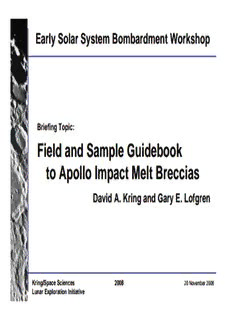
Field and Sample Guidebook to Apollo Impact Melt Breccias PDF
Preview Field and Sample Guidebook to Apollo Impact Melt Breccias
Early Solar System Bombardment Workshop Briefing Topic: Field and Sample Guidebook to Apollo Impact Melt Breccias David A. Kring and Gary E. Lofgren Kring/Space Sciences 2008 20 November 2008 Lunar Exploration Initiative Contents Introduction 3 Simple and Complex Crater Formation 5 Classification of lunar impact breccias 11 Examples of lunar impact breccias 14 Field setting Rationale for collecting these specimens Science outcomes (including surprises) References and other useful resources 68 Kring/Space Sciences 2008 Lunar Exploration Initiative Introduction Lunar impact breccias are complex lithologies. When first examined in The late 1960’s and early 1970’s, they often vexed the community because (i) the thoroughness with which impact cratering modified the lunar surface was not commonly appreciated, (ii) few terrestrial analogues of impact breccias existed, and (iii) even fewer geologists were familiar with those terrestrial analogues and the effects of impact shock on planetary surface materials. As scientists tried to understand the rocks, they struggled with interpretations of the textures in them and terminology. For that reason, literature descriptions of the same rock may vary considerably, confusing modern investigators who try to fathom previous results in the literature. Fortunately, the Apollo experience was a catalyst for impact cratering studies. A more coherent use of terminology now exists. In addition, the links between petrographic properties of these rocks and the physical processes that generated them during impact events are much better understood than they were 40 years ago. Kring/Space Sciences 2008 Lunar Exploration Initiative Introduction As we prepare for a new generation of lunar sample studies under the auspices of The Constellation Program, we are compiling information about a few examples of lunar impact breccias. Excerpts appear below. For the purposes of this workshop, we have designed the notes below and selected a suite of Apollo samples to: • Illustrate the rationale for selecting a sample of an impact melt breccia on the lunar surface, followed by the analytical results • Illustrate the complexity of impact melt breccias • Facilitate a discussion of interpretations of sample chronology • Facilitate a discussion of sampling strategies for future crater samples selected for chronology Kring/Space Sciences 2008 Lunar Exploration Initiative Simple and Complex Craters Kring/Space Sciences 2008 Grieve & Kring (2007) Lunar Exploration Initiative Simple and Complex Craters The transition diameter between simple and complex crater morphologies on the Moon is ~20 km. The transition diameter is a function of planetary gravity. On the Earth, the trans- ition diameter is 2 to 4 km, depending on target lithology. Kring/Space Sciences 2008 Kring (2006) Lunar Exploration Initiative Simple Crater Formation Kring/Space Sciences 2008 Kring (2006) Lunar Exploration Initiative See also French (1998) Simple Crater Formation Kring/Space Sciences 2008 Kring (2006) Lunar Exploration Initiative See also French (1998) Complex Crater Formation Kring/Space Sciences 2008 Kring (2006) Lunar Exploration Initiative See also French (1998) Shock and Excavation Kring/Space Sciences 2008 Kring (2006) Lunar Exploration Initiative
Description: